Table of contents
I analyzed 15 life insurance calculators to answer the burning question:
How much life insurance should you get?
I looked at the recommended amount to buy. I looked at the ease of use. I even looked at the design of the calculator.
What did I learn? More importantly, which one should you use?
Let’s get started.

First, let’s go over what makes a good life insurance calculator.
A good life insurance calculator needs to:
1. Have inputs for all the important parameters, such as your income and mortgage balance. Your life insurance needs are based on your family’s cash* and income needs when you die reduced by your existing life insurance**, so the tool should have inputs for all these amounts. It should let you choose the percentage of your income to replace and for how many years.
2. Be quick and easy to use. It should assist you whenever necessary, like giving tips on the amount needed for children’s education or final expenses.
3. Display the calculated amount clearly and show how it arrived at that amount.
4. Show you how much that amount of insurance will approximately cost to buy and point you in the direction of buying it.
5. Let you save and print the result so you can bring it to your life insurance or financial advisor to review.
6. Calculate your spouse‘s life insurance needs as well.
7. Most importantly, calculate the right amount of insurance to buy. Too little and you will be underinsured. Too much and you will spend more than you need to. As mentioned above, your life insurance needs are based on your family’s cash* and income needs at death reduced by your existing life insurance**, so it should take your input and come up with a sensible amount to recommend.
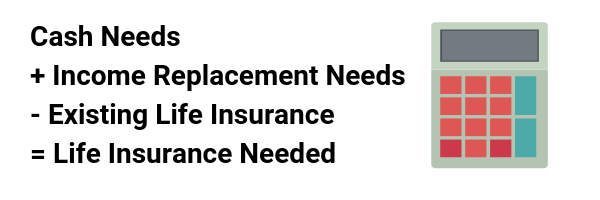
* Cash needs include paying off the mortgage and other debts, funding an emergency and education fund, and paying for final expenses such as taxes and funeral costs.
** Besides existing life insurance, your needs can also be reduced by other assets such as your savings and investments if you choose to. I prefer to leave those accounts untouched since they have other purposes like saving for retirement.
Here is a Summary of My Key Findings:
1. All the calculators used have inputs for basic things like income and mortgage balance. Some let you put in how much you need for funeral expenses, children’s education funds, and an emergency fund. A few take it too far and include business assets and rental properties too. These assets aren’t usually sold when you die so I prefer to ignore them in the calculation.
2. Most of the calculators are straightforward and only takes a couple of minutes to go through. Some provide a guide so you know how much to put for things like funeral expense and children’s education by giving you the average cost across Canada.
3. Only a handful of calculators follow the formula above of adding cash and income needs and subtracting existing life insurance. While it’s nice to know the breakdown between each component, all you need to know in the end is the actual amount to buy.
4. What’s the next step after finding how much life insurance you need? Knowing how much it’ll cost to buy it of course! Not many calculators also provide a quote so this is a valued addition to any tool.
5. Another handy tool is the ability to print or save the results as a PDF. Unfortunately, only a small number of calculators let you do this.
6. Of the 15 calculators tested, only 3 also let you calculate your spouse’s insurance needs at the same time. Although it’s not a dealbreaker since you can always reuse the tool with your spouse’s information.
7. I used the same inputs for all the calculators so I could make an apples to apples comparison. Not surprisingly, the results varied widely with the lowest recommendation being $440,376 and the highest being $820,000. This is mainly due to some tools not letting you set a percentage of your income to replace. Instead, it defaults to 100% which will result in overinsurance. Most life insurance agents recommend a lower amount of 50-70% income replacement because:
a. The mortgage and other debts will be paid off,
b. The percentage is based on gross income but insurance proceeds are tax-free, and
c. Expenses are reduced because there’s one less person in the household.
The Best Life Insurance Calculator
I do the research on the best life insurance calculator to use so you don’t have to. Here’s who has the best tools around.
Best all-around: My pick for the best all-around life insurance calculator goes to Sun Life. It has all the inputs you need and calculates the right amount of insurance. You can see the cost of insurance right away and save a copy of the results for later use. And it’s all wrapped up in a beautiful design so you’ll actually want to use it.
Best for laddering life insurance: Laddering is a strategy where you stack term policies of different length on top of each other. For example, you buy a term-10, term-20, and term-30 policy. This generates coverage that declines over the years automatically.
While you may need a large amount of life insurance now, you will need less as you get closer to retirement and pay off your debts. Laddering provides you with adequate coverage while saving you thousands over the life of your policy.
The best calculator for laddering goes to ivari which has the only calculator that gives you the results in a laddered format.
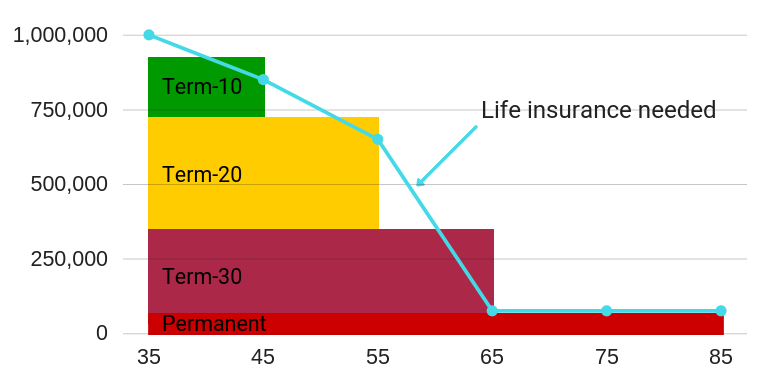
Best for life, disability, and critical illness: If you need to calculate your disability and critical illness insurance needs as well, Manulife has the only calculator capable of doing so. Because of the extra information given, this calculator takes the longest to complete.
Life Insurance Calculator Review
To compare apples to apples, I used the same assumptions for every calculator, including age, income, mortgage balance, etc. Keep in mind not every calculator asked for every input. Here are the assumptions I used:
Basic information
- Age: 35-year-old
- Gender: Male
- Smoking status: Non-smoker
- Marital status: Married
- Number of children: 1
- Age of child: 1
- Existing life insurance: None
- Inflation rate: 2%
Income replacement at death
- Pre-tax income: $50,000
- After-tax income: $40,000
- Percentage of income to replace: 50%
- Number of years to replace income: 10 years
- Rate of return on invested death benefit: 5%
Net worth
- Savings: $5,000
- Registered account investments: $20,000
- Mortgage balance: $250,000
- Number of years left in amortization: 25 years
- Mortgage interest rate: 3%
- Other debt: $20,000
- Other debt interest rate: 8%
Cash needs at death
- Child’s education: $25,000
- Funeral expenses: $10,000
Sun Life

 Pros: Sun Life’s insurance calculator is extremely quick and easy to use, letting you generate a result in less than 2 minutes. It covers all the important parameters without getting too complicated. Besides giving you the approximate cost in the results page, it also lets you adjust the insurance amount to see the change in cost. It also does a good job explaining the assumptions such as the inflation rate and expected rate of return. As a bonus, Sun Life’s calculator is well-designed and actually makes you want to use it.
Pros: Sun Life’s insurance calculator is extremely quick and easy to use, letting you generate a result in less than 2 minutes. It covers all the important parameters without getting too complicated. Besides giving you the approximate cost in the results page, it also lets you adjust the insurance amount to see the change in cost. It also does a good job explaining the assumptions such as the inflation rate and expected rate of return. As a bonus, Sun Life’s calculator is well-designed and actually makes you want to use it.
 Cons: You can’t change the assumptions such as the rate of return and the inflation rate. Also, like most other calculators, it doesn’t let you calculate your spouse’s life insurance needs at the same time.
Cons: You can’t change the assumptions such as the rate of return and the inflation rate. Also, like most other calculators, it doesn’t let you calculate your spouse’s life insurance needs at the same time.
Life insurance needed: $499,404

iA Financial Group

 Pros: iA Financial Group’s life insurance calculator is extremely quick and easy to use. Besides giving you the approximate cost in the results page, it also lets you adjust the insurance amount to see the change in cost.
Pros: iA Financial Group’s life insurance calculator is extremely quick and easy to use. Besides giving you the approximate cost in the results page, it also lets you adjust the insurance amount to see the change in cost.
 Cons: It’s a bit too basic – it doesn’t let you choose the percentage of income to replace and how many years you need it replaced. The calculator is also missing other important factors such as the funeral expense. It doesn’t let you save a copy of the results but it does let you email it.
Cons: It’s a bit too basic – it doesn’t let you choose the percentage of income to replace and how many years you need it replaced. The calculator is also missing other important factors such as the funeral expense. It doesn’t let you save a copy of the results but it does let you email it.
Life insurance needed: $670,000
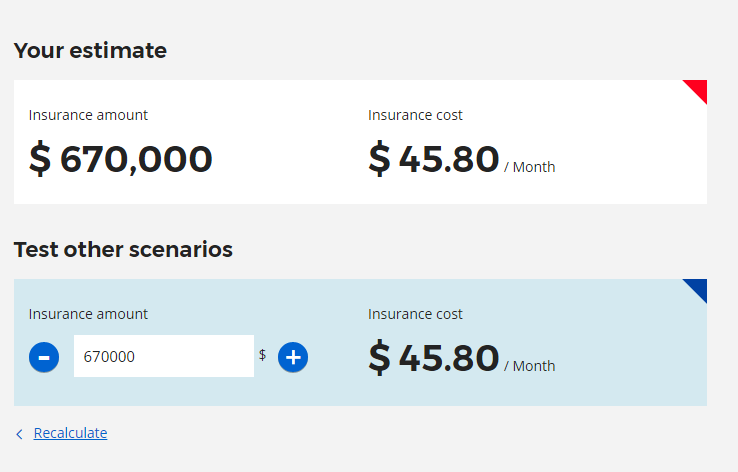
RBC Insurance
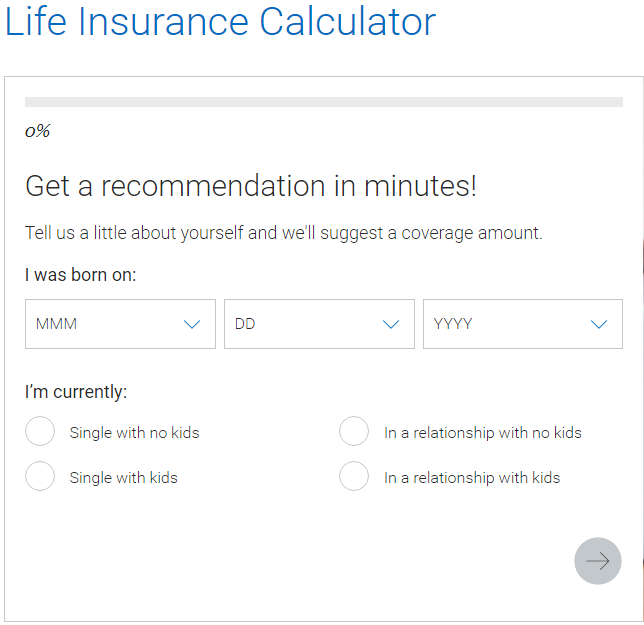
 Pros: RBC Insurance’s life insurance calculator takes you through 4 screens which are straightforward and quick to complete. It has helpful suggestions for things like how many years to provide an income to your loved ones for.
Pros: RBC Insurance’s life insurance calculator takes you through 4 screens which are straightforward and quick to complete. It has helpful suggestions for things like how many years to provide an income to your loved ones for.
 Cons: This calculator lacks some basic functionality like the ability to choose the percentage of income to replace or letting you reduce the insurance needs with current life insurance coverage. Out of all the tools, RBC Insurance’s will recommend the highest amount of coverage.
Cons: This calculator lacks some basic functionality like the ability to choose the percentage of income to replace or letting you reduce the insurance needs with current life insurance coverage. Out of all the tools, RBC Insurance’s will recommend the highest amount of coverage.
Life insurance needed: $820,000

BMO Insurance

 Pros: It has quite a few more inputs than other calculators, such as the value of your real estate holdings, your business assets, etc. Unless you plan on selling them when you die, I wouldn’t bother filling these in. It also applies the formula of adding your cash needs to your income needs minus your existing life insurance to determine your life insurance needs.
Pros: It has quite a few more inputs than other calculators, such as the value of your real estate holdings, your business assets, etc. Unless you plan on selling them when you die, I wouldn’t bother filling these in. It also applies the formula of adding your cash needs to your income needs minus your existing life insurance to determine your life insurance needs.
 Cons: Because it doesn’t ask your age, gender and smoking status, this calculator doesn’t give you an approximate cost of insurance. It also doesn’t show assumptions like the inflation rate and the rate of return on the invested death benefit.
Cons: Because it doesn’t ask your age, gender and smoking status, this calculator doesn’t give you an approximate cost of insurance. It also doesn’t show assumptions like the inflation rate and the rate of return on the invested death benefit.
Life insurance needed: $473,000

Canada Protection Plan
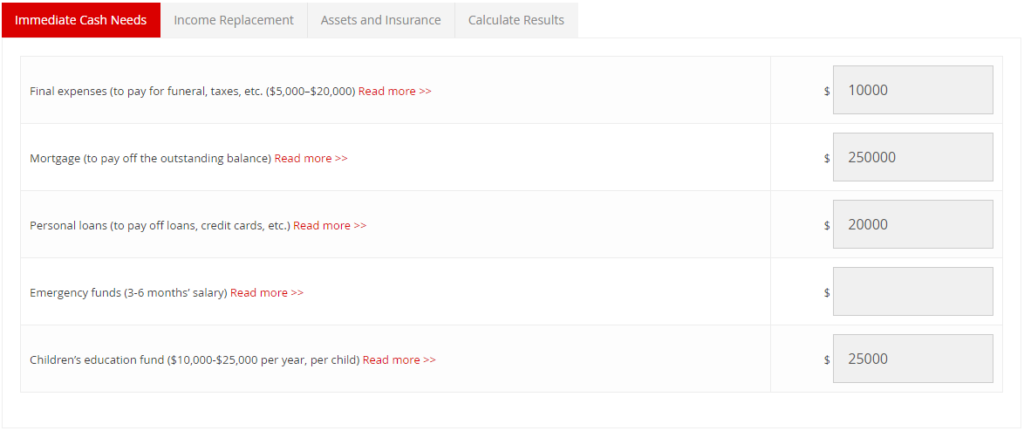
 Pros: CPP’s life insurance calculator is quick and easy to use. It has helpful suggestions for things like how much you need for funeral expenses and children’s education costs. It also clearly shows how it arrived at the recommended life insurance amount by adding cash and income replacement needs and subtracting existing insurance.
Pros: CPP’s life insurance calculator is quick and easy to use. It has helpful suggestions for things like how much you need for funeral expenses and children’s education costs. It also clearly shows how it arrived at the recommended life insurance amount by adding cash and income replacement needs and subtracting existing insurance.
 Cons: The calculator doesn’t ask your age, gender and smoking status so it doesn’t give you an approximate cost of insurance. It also doesn’t let you choose the percentage of income to replace. Finally, its design is plain compared to other insurance company’s calculators.
Cons: The calculator doesn’t ask your age, gender and smoking status so it doesn’t give you an approximate cost of insurance. It also doesn’t let you choose the percentage of income to replace. Finally, its design is plain compared to other insurance company’s calculators.
Life insurance needed: $679,960

Government of Canada website
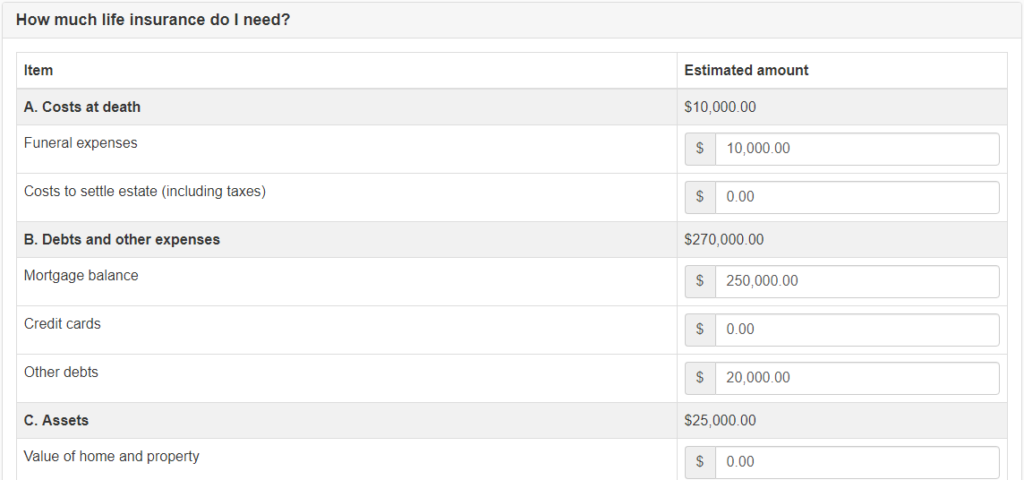
 Pros: Because the source is the government and not an insurance company, the recommendation should be impartial and not push you toward a higher amount to sell you more insurance.
Pros: Because the source is the government and not an insurance company, the recommendation should be impartial and not push you toward a higher amount to sell you more insurance.
 Cons: The income replacement is based on expenses instead of income, making it more difficult to compare with other calculators. Its design is plain compared to other insurance company’s calculators. And for some reason, it includes spouse’s income which reduces the recommended amount.
Cons: The income replacement is based on expenses instead of income, making it more difficult to compare with other calculators. Its design is plain compared to other insurance company’s calculators. And for some reason, it includes spouse’s income which reduces the recommended amount.
Life insurance needed: $655,000

Manulife

 Pros: Manulife’s life insurance calculator not only solves your life insurance needs but also your disability and critical illness insurance needs at the same time. Like some other calculators, it lets you adjust the insurance amount in the results to see the change in cost. And because Manulife has a unique product called Synergy, the calculator also compares to the cost of Synergy which combines all 3 of life, disability and critical illness coverages in 1 policy. Lastly, it’s one of the few calculators that recommends an amount for you and your spouse.
Pros: Manulife’s life insurance calculator not only solves your life insurance needs but also your disability and critical illness insurance needs at the same time. Like some other calculators, it lets you adjust the insurance amount in the results to see the change in cost. And because Manulife has a unique product called Synergy, the calculator also compares to the cost of Synergy which combines all 3 of life, disability and critical illness coverages in 1 policy. Lastly, it’s one of the few calculators that recommends an amount for you and your spouse.
 Cons: The downside of providing disability and critical illness needs as well is that it makes the calculator much longer and more tedious to use. If you only need to know your life insurance amount, you can skip the other sections.
Cons: The downside of providing disability and critical illness needs as well is that it makes the calculator much longer and more tedious to use. If you only need to know your life insurance amount, you can skip the other sections.
Life insurance needed: $473,043
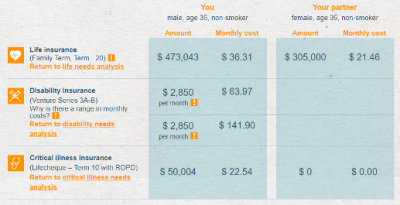
Term4sale
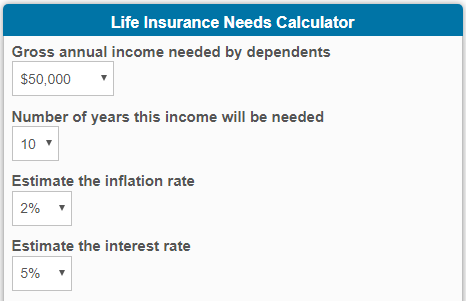
 Pros: Term4sale’s life insurance calculator is one of the only ones that let you adjust the assumptions such as inflation and return rates which could be helpful if you don’t like the default values. It’s also the only one on this list that lets you compare quotes from different carriers instantly so you can find the best deal.
Pros: Term4sale’s life insurance calculator is one of the only ones that let you adjust the assumptions such as inflation and return rates which could be helpful if you don’t like the default values. It’s also the only one on this list that lets you compare quotes from different carriers instantly so you can find the best deal.
 Cons: It does not have any inputs for debts and other cash needs such as funeral expenses, meaning this is purely an income replacement analysis. So if you have a mortgage or other debts, this calculator will underestimate your needs.
Cons: It does not have any inputs for debts and other cash needs such as funeral expenses, meaning this is purely an income replacement analysis. So if you have a mortgage or other debts, this calculator will underestimate your needs.
Life insurance needed: $440,376

Foresters Financial
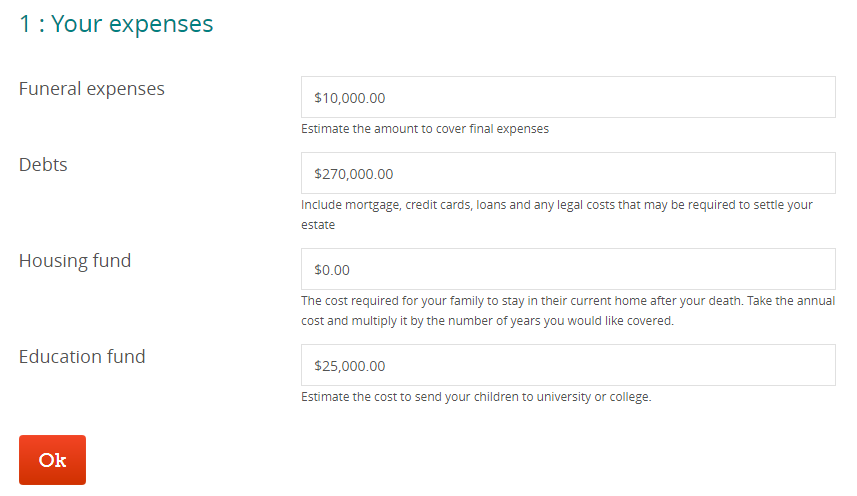
 Pros: Foresters’ life insurance calculator is quick and easy to use. It also clearly breaks down the components of the life insurance need into cash plus income needs minus existing insurance.
Pros: Foresters’ life insurance calculator is quick and easy to use. It also clearly breaks down the components of the life insurance need into cash plus income needs minus existing insurance.
 Cons: It doesn’t let you print or save the results, nor does it have a handy quoting tool to let you know how much the coverage will approximately cost.
Cons: It doesn’t let you print or save the results, nor does it have a handy quoting tool to let you know how much the coverage will approximately cost.
Life insurance needed: $679,960
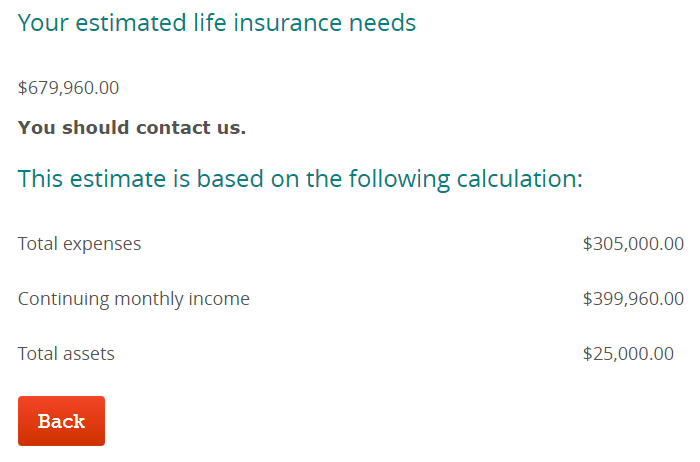
Edward Jones
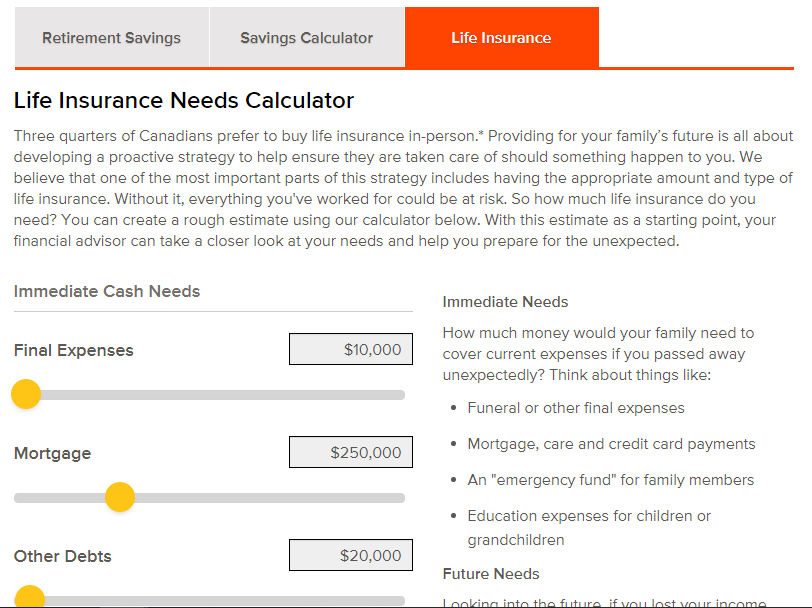
 Pros: Edward Jones’ life insurance calculator is one of the few that lets you adjust the assumptions such as inflation and return rates which could be helpful if you don’t like the default values. It’s also more visually appealing than most of the rest and lets you adjust the values to dynamically visualize the change in the results.
Pros: Edward Jones’ life insurance calculator is one of the few that lets you adjust the assumptions such as inflation and return rates which could be helpful if you don’t like the default values. It’s also more visually appealing than most of the rest and lets you adjust the values to dynamically visualize the change in the results.
 Cons: It doesn’t give you any tips on the amount to use for things like final expenses and children’s education. You also can’t choose a lower rate of return than 5.5% which is unreasonable considering the low interest rate environment we live in.
Cons: It doesn’t give you any tips on the amount to use for things like final expenses and children’s education. You also can’t choose a lower rate of return than 5.5% which is unreasonable considering the low interest rate environment we live in.
Life insurance needed: $711,590
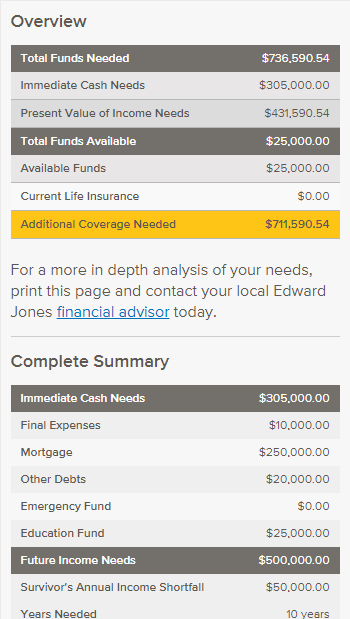
The Co-operators

 Pros: The Co-operators’ life insurance calculator is quick and easy to use. It produces a simple 1-page PDF that you can bring to your insurance agent to discuss.
Pros: The Co-operators’ life insurance calculator is quick and easy to use. It produces a simple 1-page PDF that you can bring to your insurance agent to discuss.
 Cons: You can’t choose the percentage of income to replace, which means your income replacement needs will be overestimated. It also doesn’t explain the assumptions such as inflation and interest rate nor does it show you how it calculated your results.
Cons: You can’t choose the percentage of income to replace, which means your income replacement needs will be overestimated. It also doesn’t explain the assumptions such as inflation and interest rate nor does it show you how it calculated your results.
Life insurance needed: $645,000
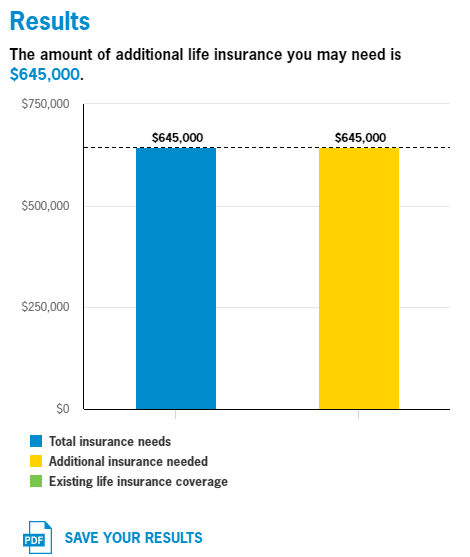
ivari

 Pros: ivari’s life insurance calculator has most of the features that make a good calculator. It:
Pros: ivari’s life insurance calculator has most of the features that make a good calculator. It:
- Breaks down your insurance needs into cash and income replacement
- Calculates your spouse’s need at the same time
- Lets you print and save a detailed analysis of the results
Besides these benefits, this is also the only life insurance calculator to give you a laddered life insurance results. Laddering is where you layer term insurance of different lengths to mimic your decreasing insurance needs over time. It realizes that while you may need a certain amount of life insurance now, you will need less as you get closer to retirement and you pay off your debts. Finally, ivari’s calculator also scores a design bonus for being very visually appealing.
 Cons: It doesn’t let you reduce the insurance needs by any existing assets or insurance. It also doesn’t show you the approximate cost of insurance.
Cons: It doesn’t let you reduce the insurance needs by any existing assets or insurance. It also doesn’t show you the approximate cost of insurance.
Life insurance needed:
- Years 1-10: $734,000
- Years 11-20: $571,000
- Years 21-30: $234,000
- Years 30+: $27,000
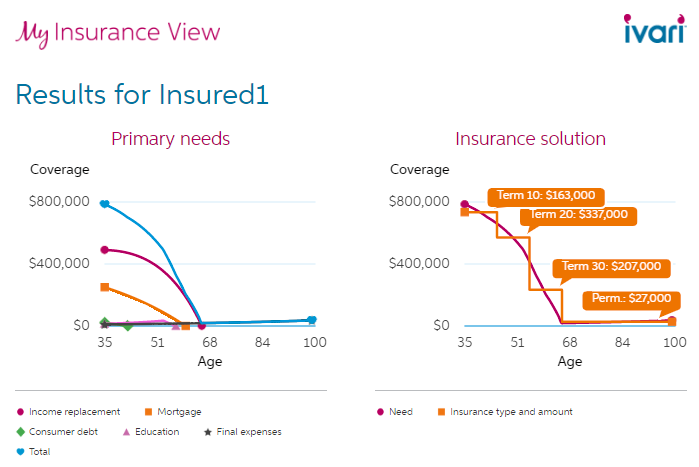
Scotiabank

 Pros: Scotiabank’s life insurance calculator is a one-page no-frills tool. It clearly breaks down the components of the life insurance need into cash plus income needs minus existing insurance. It’s also one of the few calculators that let you adjust the inflation rate and rate of return.
Pros: Scotiabank’s life insurance calculator is a one-page no-frills tool. It clearly breaks down the components of the life insurance need into cash plus income needs minus existing insurance. It’s also one of the few calculators that let you adjust the inflation rate and rate of return.
 Cons: It doesn’t ask for your age, gender and smoking status so it doesn’t give you an approximate cost of insurance. You also can’t save a copy of the results for future reference.
Cons: It doesn’t ask for your age, gender and smoking status so it doesn’t give you an approximate cost of insurance. You also can’t save a copy of the results for future reference.
Life insurance needed: $450,604
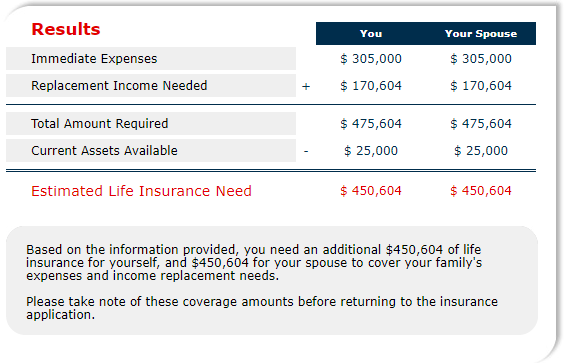
Insurance Supermarket Inc. (ISI)
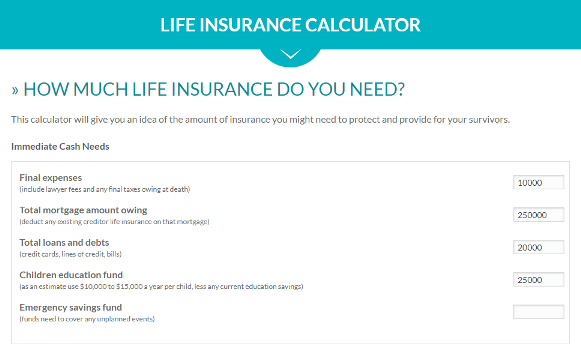
 Pros: ISI’s life insurance calculator is quick and easy to use. It also clearly breaks down the components of the life insurance need into cash plus income needs minus existing insurance.
Pros: ISI’s life insurance calculator is quick and easy to use. It also clearly breaks down the components of the life insurance need into cash plus income needs minus existing insurance.
 Cons: It doesn’t let you print or save the results, nor does it have a handy quoting tool to let you know how much the coverage will approximately cost.
Cons: It doesn’t let you print or save the results, nor does it have a handy quoting tool to let you know how much the coverage will approximately cost.
Life insurance needed: $530,000
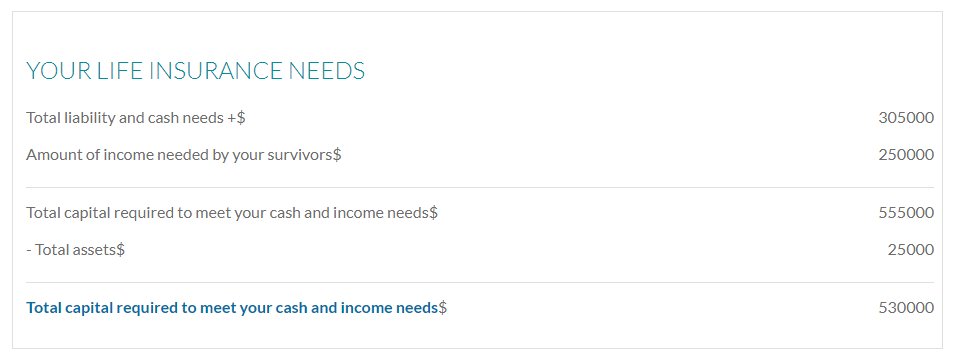
Empire Life

 Pros: Empire Life’s life insurance calculator has a handy link to a quoting tool to buy either their simplified term insurance product immediately or contact a life insurance agent to buy the fully underwritten term insurance product. Simplified term insurance is more expensive and has a lower maximum limit, but skips most of the tedious parts of underwriting.
Pros: Empire Life’s life insurance calculator has a handy link to a quoting tool to buy either their simplified term insurance product immediately or contact a life insurance agent to buy the fully underwritten term insurance product. Simplified term insurance is more expensive and has a lower maximum limit, but skips most of the tedious parts of underwriting.
 Cons: For income replacement, it suggests using 100% of your income instead of a lower amount like 50-70%. This will result in overestimating your insurance needs.
Cons: For income replacement, it suggests using 100% of your income instead of a lower amount like 50-70%. This will result in overestimating your insurance needs.
Life insurance needed: $755,000

Conclusion
Have you used any of these life insurance calculators? What did you think of the results?
Let me know what you think in the comments below.
Get Your Life Insurance Quote Now
While we make every effort to keep our site updated, please be aware that timely information on this page, such as quote estimates, or pertinent details about companies, may only be accurate as of its last edit day. Brian So Insurance and its representatives do not give legal or tax advice. Please consult your own legal or tax adviser. This post is a brief summary for indicative purposes only. It does not include all terms, conditions, limitations, exclusions, and other provisions of the policies described, some of which may be material to the policy selection. Please refer to the actual policy documents for complete details which can be provided upon request. In case of any discrepancy, the language in the actual policy documents will prevail. A.M. Best financial strength ratings displayed are not a warranty of a company’s financial strength and ability to meet its obligations to policyholders.


Excellent analysis. Thanks for the information!